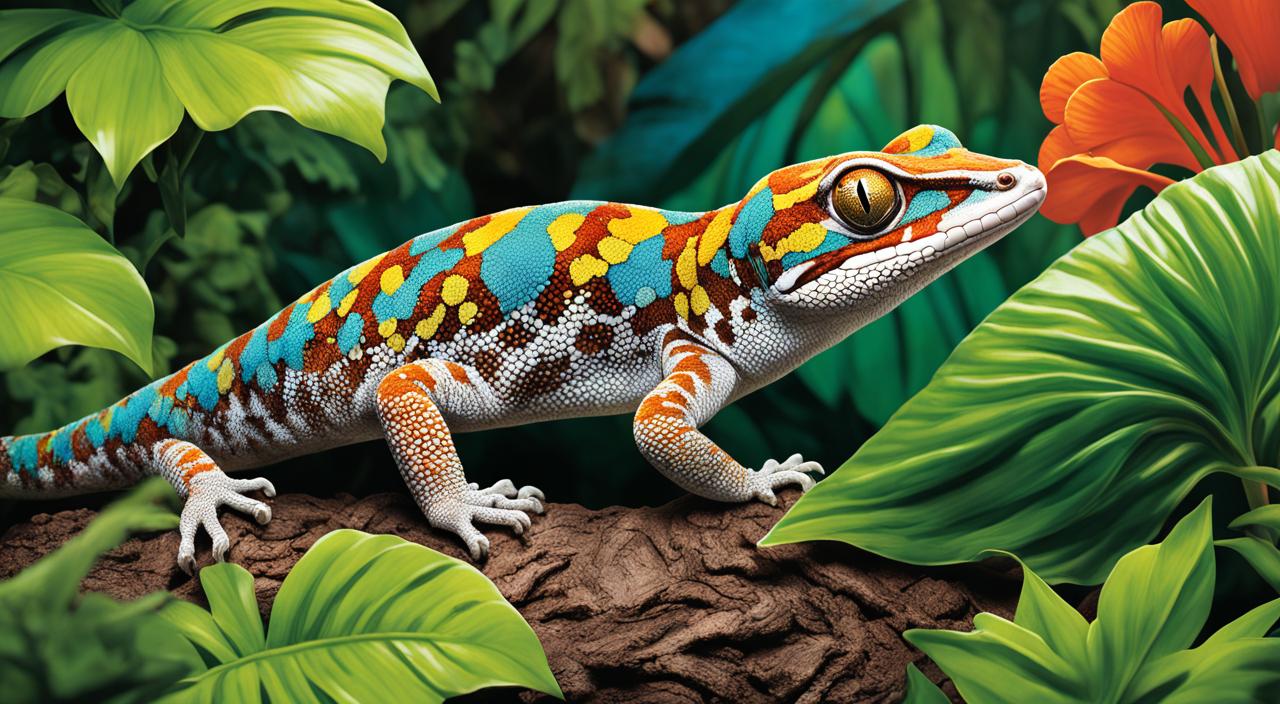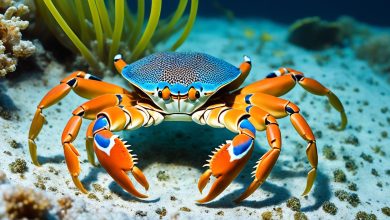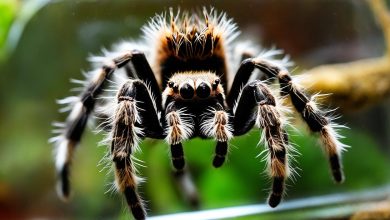In the Pacific Ocean, New Caledonia is home to a special reptile: the New Caledonian Giant Gecko. This gecko is the biggest living gecko on Earth, reaching lengths of up to 17 inches (43 cm). Its size and unique look make it stand out from other geckos.
Introduction to the New Caledonian Giant Gecko
The New Caledonian Giant Gecko lives in the Pacific islands of New Caledonia. It’s the largest living gecko species. These geckos can grow up to 17 inches (43 cm) long, making them giants among geckos.
Endemic to the Pacific Islands
This gecko is an endemic species. It’s only found in New Caledonia. The French territory in the Pacific Ocean is perfect for these unique geckos. They’ve adapted to the island’s diverse landscapes and ecosystems.
The Largest Living Gecko Species
The New Caledonian Giant Gecko belongs to the species Rhacodactylus leachianus. It’s the largest gecko species on the planet. They can grow up to 17 inches (43 cm) long and weigh up to 500 grams.
| Locality | Size Range | Weight Range |
|---|---|---|
| Grande Terre | 14–17 inches (360–430 mm) | 250-500 grams |
| Insular Localities | 9–12 inches (23–30 cm) | 150-300 grams |
The New Caledonian Giant Gecko comes in many colors and patterns. You can see green, brown, gray, black, white, pink, and yellow. This makes them very visually appealing.
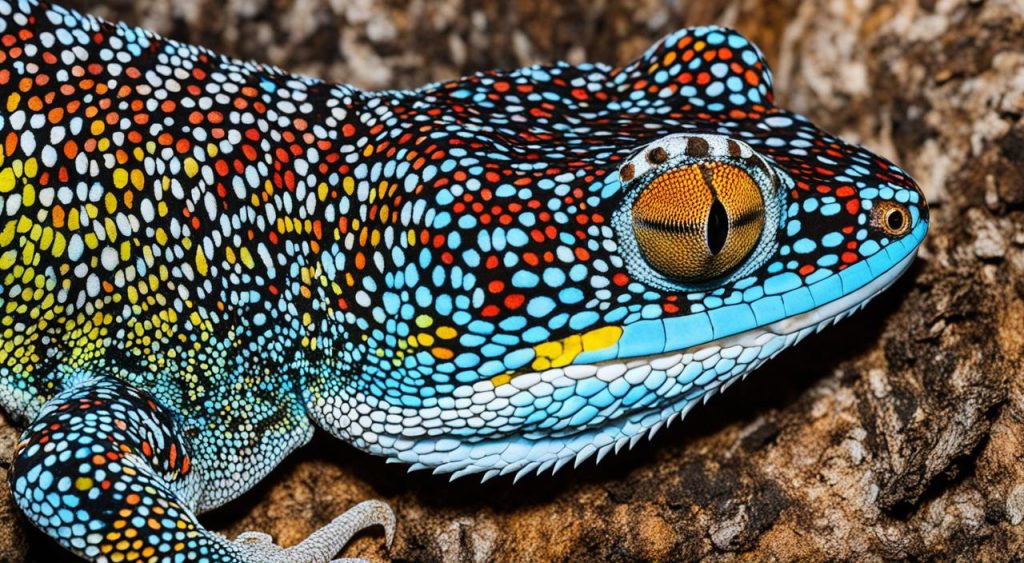
“The New Caledonian Giant Gecko is a true marvel of evolution, adapting to the unique island ecosystems of its native habitat.”
Fascinating Physical Traits
The New Caledonian Giant Gecko is known for its stunning physical traits. These reptiles come in a variety of coloration, from browns and grays to maroon. Some have stripes or spots, making them even more eye-catching.
These geckos are also large. They can grow up to 17 inches (43 cm) long, making them the biggest gecko species. Their size makes them stand out, showing off their impressive presence.
| Physical Trait | Description |
|---|---|
| Size | Maximum length of 17 inches (43 cm) |
| Coloration | Ranges from brown and gray to maroon, with possible patterns of stripes or spots |
| Unique Features | Large size, adhesive toe pads, and a distinct crest-like feature on their heads |
These geckos have more than just coloration and size to offer. They have special toe pads for climbing and a unique head crest. These features make them even more fascinating.
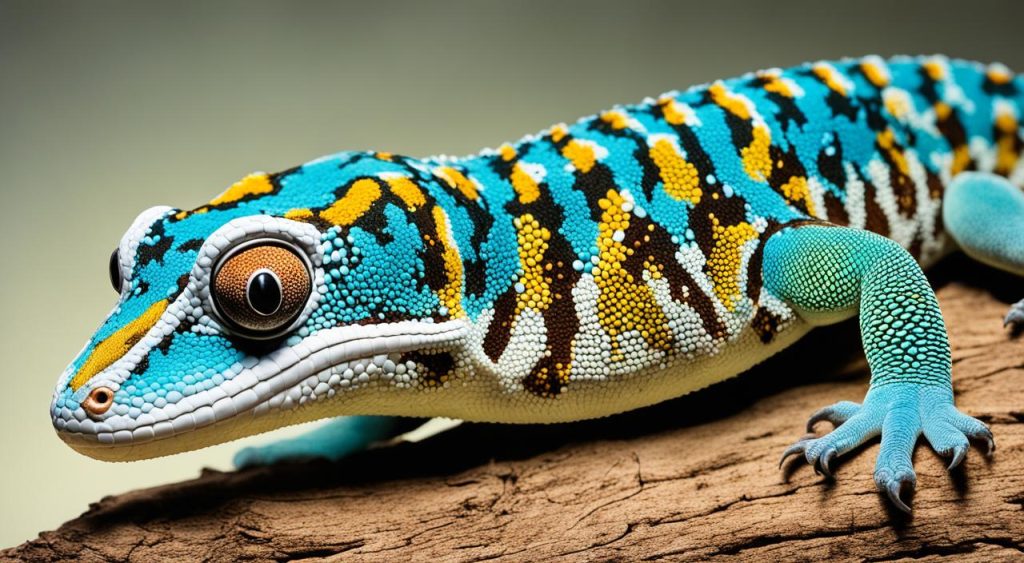
“The New Caledonian Giant Gecko is a true marvel of nature, showcasing a remarkable blend of physical traits that set it apart from other gecko species.”
Habitat and Distribution
The New Caledonian Giant Gecko, known as Rhacodactylus leachianus, lives in the forests of New Caledonia. This place is a French territory in the South Pacific. It thrives in the lush, tropical rainforests of this remote area.
These geckos spend most of their time in the trees and shrubs. They use their strong limbs and tails to move around. They live from 500 to 1,100 meters high on the main island, Grande Terre, except in the northeast.
Diverse Habitats and Geographic Variations
In New Caledonia’s forests, the New Caledonian Giant Gecko shows a lot of size and color differences. For example, geckos in Goro can be up to 17 inches long and weigh 500 grams. Those in Yate can be over 15 inches long and weigh more than 400 grams.
| Locality | Size Range | Weight Range | Coloration |
|---|---|---|---|
| Grande Terre | 14-17 inches (360-430 mm) | 250-500 grams | Variable |
| Insular Localities | 9-12 inches (23-30 cm) | 150-300 grams | Variable |
| Mount Khogis | Up to 15 inches | Over 300 grams | Jet black to olive green |
| Poindimie | Up to 15 inches | Over 400 grams | Variable, including lean builds |
| Mount Humboldt | Up to 15 inches | Up to 420 grams | Variable with white blotches |
| Brosse | Up to 10 inches | Around 250 grams | Yellow or green with large pink/white blotching |
| Bayonnaise | N/A | N/A | Yellow-green base with banding |
| Nuu Ana | Up to 9 inches | Under 200 grams | Greenish yellow with large colorful blotching |
| Nuu Ami | N/A | Up to 200 grams | Deep greens to bright yellows with white/pink blotching |
| Duu Ana | N/A | N/A | Dark green-brown base with larger legs |
| Isle of Pines | Up to 12 inches | Over 300 grams | Variable |
The size and color changes show how adaptable and diverse the New Caledonian Giant Gecko is in its forests. It lives across the islands of New Caledonia.
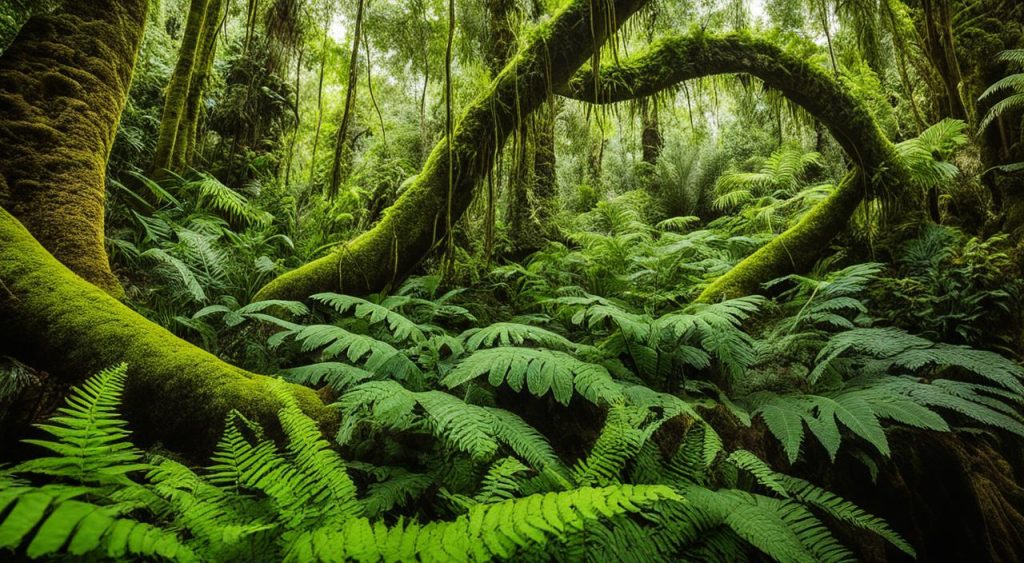
Behavior and Lifestyle
The New Caledonian Giant Gecko is a fascinating creature. It shows unique behaviors and an interesting lifestyle. These geckos live mostly in the trees, using their strong arms and tails to move around.
They are arboreal, spending most of their time in the forest’s lush vegetation. They can easily climb trees and jump from branch to branch.
At night, these geckos become nocturnal hunters. They hunt for insects, small animals, and fruit using their great night vision. This helps them avoid the hot sun and predators during the day.
| Behavior Characteristics | Details |
|---|---|
| Arboreal Existence | Spend majority of time in trees and vegetation |
| Nocturnal Hunting | Actively hunt at night using excellent night vision |
| Prey and Diet | Insects, small vertebrates, and fruit |
| Vocalization | Barks, growls, yips, and screeches |
| Territoriality | Can be aggressive towards other geckos |
The New Caledonian Giant Gecko’s behavior and lifestyle are amazing. They have adapted well to their island home. Their arboreal and nocturnal ways help them live in the diverse forests of New Caledonia.
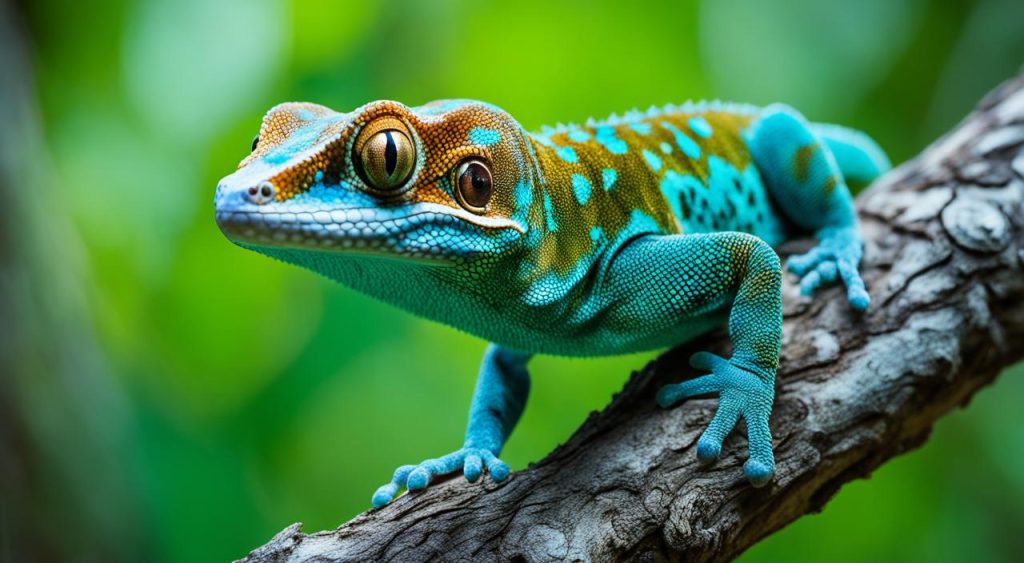
New Caledonian Giant Gecko
The New Caledonian Giant Gecko, known as Rhacodactylus leachianus, is the biggest gecko alive today. These reptiles live in New Caledonia and have adapted to its unique environment. They are big, have special looks, and interesting behaviors that make them interesting to those who love reptiles and conservation.
Rhacodactylus leachianus can grow up to 14 inches long, making it the biggest living gecko. This is bigger than the Tokay Gecko, which is the second biggest, by a lot.
These geckos can change color like chameleons do, based on the sunlight. This helps them hide in trees and catch prey better.
“New Caledonian giant geckos can cling to a person and suck their soul out, earning them the nickname ‘devils in the trees.'”
Despite local myths, the new caledonian giant gecko is a fascinating creature. It’s important to protect these reptiles and their homes. This will help them survive for many years.
New Caledonia is also home to other cool geckos like the gargoyle and eyelash geckos. Each one has its own special look. This island is a paradise for those who love reptiles, showing how diverse and adaptable these creatures are.
Conservation Status and Threats
The New Caledonian Giant Gecko is listed as Least Concern by the IUCN Red List. But, they face threats like habitat loss and invasive species.
Humans have cut down forests for nickel mining and building cities, reducing their home. Predators like rats, cats, and dogs threaten them. Power lines also kill them by electrocution.
These geckos are also hunted for pets, even though they’re not endangered. Losing their home and invasive species are big challenges for their survival.
Habitat Disruption and Invasive Species
The New Caledonian Giant Gecko lives only in New Caledonia, where much of its forest is gone. Now, only 5% of the original forest is left. Nickel mining and deforestation are the main reasons.
- New Caledonia is down to only 5% of its original forest landscape
- The island of New Caledonia supports some of the world’s highest levels of endemic species
- Nickel mining and deforestation have almost eradicated the forests in New Caledonia and the East Melanesian islands
Invasive species like rodents, cats, and fire ants are a big threat. They eat the geckos, making their numbers go down.
| Threats to the New Caledonian Giant Gecko | Impact |
|---|---|
| Habitat Loss and Degradation | Reduction of available living space due to deforestation and urbanization |
| Invasive Species Predation | Predation by introduced rodents, cats, and fire ants |
| Illegal Collection for Pet Trade | Removal of individuals from the wild population |
| Electrocution from Power Lines | Accidental deaths due to power lines built through their habitat |
Despite the problems, the New Caledonian Giant Gecko is widespread and has a stable population. Some live in protected areas. Conservation efforts are working to save this unique reptile.
Captive Care and Breeding
The New Caledonian Giant Gecko can be a great pet for those who love reptiles. They need special care and a habitat that feels like their natural home in New Caledonia’s forests.
For these geckos, captive care is key to their health. They eat slowly and need the right amount of food. Adults can be 14 to 17 inches long, weighing 212 to 279 grams. Smaller ones are 9 to 12 inches long and weigh 115 to 250 grams.
| Captive Care Requirements | Specification |
|---|---|
| Enclosure Size | Baby Geckos: 5-10 gallon tall terrarium Sub-adult/Adult: 18x18x36 or 18x18x24 inches |
| Temperature | 73-80°F (23-27°C) |
| Humidity | 60-70% |
| Lighting | 5-7% UVB, compact lamps every 6 months, T5 UVB tubes annually |
| Diet | Pangea Complete Diet, Dubia roaches, crickets, blended fruit (low phosphorus) |
| Supplements | Osteo-form SA, Vionate Powder |
Breeding these geckos in captivity works well. Females have 1-3 babies after 60-90 days of incubation. They can have 2-5 clutches a year. These geckos can live up to 20 years with proper captive care.
When handling these geckos, be careful. They have different personalities. Don’t handle hatchlings until they are 2-3 months old. Always be gentle to avoid hurting them.
Ecotourism and Conservation Efforts
The New Caledonian Giant Gecko draws ecotourists with its unique traits and endemic status. Visitors can see these reptiles in their natural setting. Conservation efforts protect the gecko’s habitat and population through reserves and protected areas. These actions help ensure the gecko’s survival for the future.
Protected Areas and Reserves
New Caledonia is rich in biodiversity, with over 3,000 native plant species, 80% of which are found only there. It has 44 species of Araucaria, 15 of which are unique to the area. The territory also shelters 48 land and 15 sea reptiles, including the world’s largest geckos.
To safeguard this ecosystem, New Caledonia has set up protected areas and reserves. The Parc des Grandes Fougères and Rivière Bleue Provincial Park are two examples. These places are home to the New Caledonian Giant Gecko and other unique species. They let visitors see these creatures in their natural setting.
The Polynesia-Micronesia Hotspot, which includes New Caledonia, is a hotspot for biodiversity. It spans over 46,000 square kilometers and is home to about 3.2 million people. This area is known for its unique plants, birds, and reptiles, with many species found only here.
Conserving the New Caledonian Giant Gecko and its home is key to protecting the region’s biodiversity. By creating protected areas and supporting ecotourism, we can ensure this amazing species thrives for generations to come.
Cultural Significance and Legends
The New Caledonian Giant Gecko has captured the hearts of the local people. They call it the “devil in the trees” because of its size and sounds. These sounds include whistles, chirps, and growls. This name adds to the mystique of this unique reptile.
In New Zealand, the Maori folklore talks about a creature called the “kawekaweau” or “kaweau.” It’s a large lizard that lives in the forest, similar to the giant gecko. People have seen these geckos in New Zealand’s remote places, but no proof has been found yet.
The Maori traditions also tell of other giant lizards like the “taniwha,” “ngarara,” and “kumi.” These stories tell of how these creatures interacted with the people. Even though there’s no solid proof of the giant gecko’s existence, some think it might have lived in the past or still exists today.
FAQ
What is the New Caledonian Giant Gecko?
The New Caledonian Giant Gecko, also known as the Leachianus Gecko, is the biggest living gecko. It lives in the Pacific islands of New Caledonia. These geckos can grow up to 17 inches (43 cm) long from head to tail.
Where is the New Caledonian Giant Gecko found?
This gecko is only found in New Caledonia, a French territory in the Pacific Ocean. They live in the coastal and mountain forests of the islands.
What are the distinctive physical traits of the New Caledonian Giant Gecko?
These geckos stand out with their varied colors, from brown to gray to maroon. Some have stripes or spots. They are also very big, reaching up to 17 inches (43 cm) long.
How do the New Caledonian Giant Geckos live and behave?
They live mostly in trees and are great climbers. Their strong arms and tails help them move through the forest. At night, they hunt for insects, small animals, and fruit.
What is the conservation status of the New Caledonian Giant Gecko?
The New Caledonian Giant Gecko is listed as Least Concern by the IUCN Red List. But, they face threats like habitat loss and invasive species. These threats harm their numbers and homes.
Can the New Caledonian Giant Gecko be kept as a pet?
Experienced reptile lovers can keep these geckos as pets. They need special care to live in captivity. They also need the right food and a big space to move around.
What is the cultural significance of the New Caledonian Giant Gecko?
This gecko is important for ecotourism in New Caledonia. Conservation efforts protect its home and numbers. Locals call it the “devil in the trees” because of its size and sounds.
